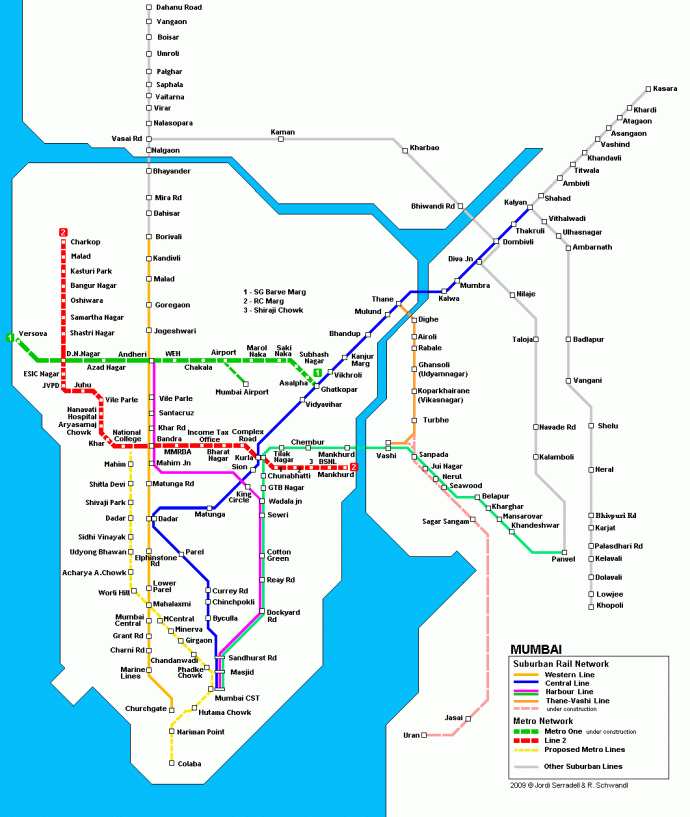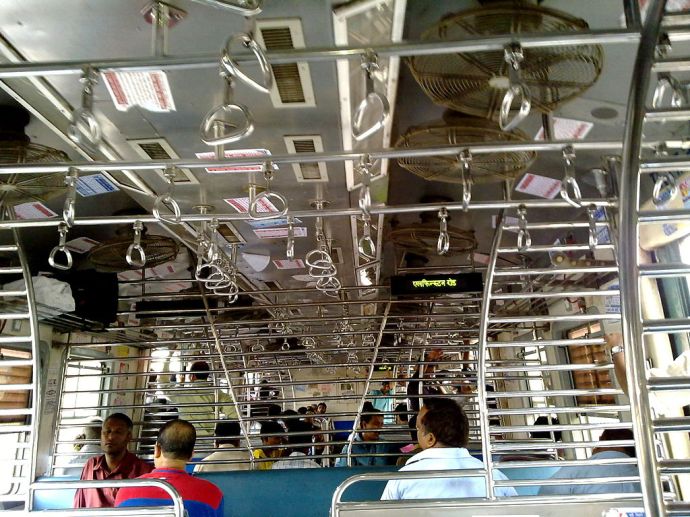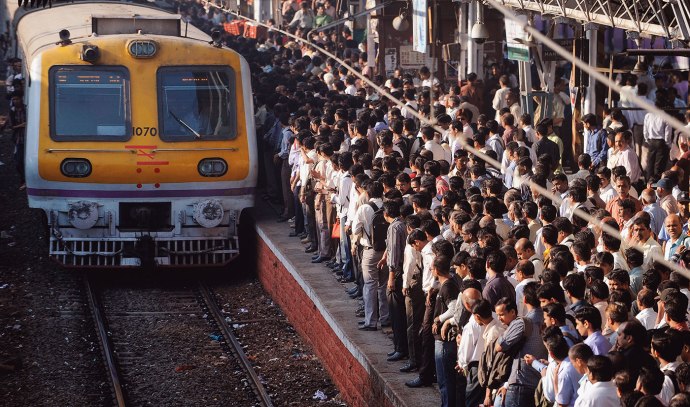In my previous post on The Dabbawallahs of Mumbai, I’ve already mentioned about the fast lifestyle of the city. However, to keep that momentum going all the time, without a break you need something that works like clockwork. Yes, in this post we focus on the Mumbai suburban railway network that certainly is the lifeline of the city.

History of Mumbai Suburban Railway
Earlier, Bombay (now Mumbai) was nothing more than an archipelago of seven islands floating close to each other. It was during the British era that these islands were reclamated to form the city that we know today.
The current Mumbai Suburban Railway is among the oldest railway systems in Asia. As per the records, the first train ran between Victoria Terminus (now CST) and Thane. The train covered a distance of 34 kilometers on 16 April, 1853 at 3:35 p.m.
Since then, there has been no looking back as the city of Bombay became the financial, entertainment and economical capital of the country. The city is very demanding and the Mumbai suburban railway has to meet its expectations.

Mumbai Suburban Railway Network
Today, the Mumbai Suburban Railway is divided into two major zones; the Western Railways and the Central Railways.
The Western Railway focuses on the western line of the city. On the other hand, the Central Railway operates the central line, harbour line and the trans-harbour line.
The Western Railway focuses on Churchgate in South Mumbai to Dahanu Road covering a distance of 120 kilometers. The trains are further divided into two categories; slow trains that halt at all stations and fast trains that halt only at important stations.
On the central side, there are three major corridors connecting from the CST in the South Mumbai. The first line connects from CST to Kalyan. It further divides into two lines, one heading towards Kasara towards north-east and the other to Khopoli in the south-east.
Although, the Central line and Western line are parallel to each other, there is one common station: Dadar. At this point you can change the lines as per your travel plans.
Central Railway also manages the Harbour Line that runs from CST to Andheri on the Western Line and Panvel on the Harbour Line. There are no fast trains on the Harbour Line. The Trans-Harbour Line connects the Navi Mumbai to Thane.
The Mumbai Suburban Railway functions like a central nervous system of the city. It criss-crosses across the city connecting different parts of the city allowing people to reach different locations.

Mumbai Suburban Railway Services
The local trains usually have 9, 12 and 15 coach rakes. Some of the coaches are reserved for ladies only and first-class passengers. The first-class fare is 12 times expensive than second class.
Every local train has Gents Second Class, Gents First Class compartments, Ladies-Only compartments, Ladies-Only First Class compartments, Handicap and Cancer Patients compartments and Senior Citizens-Only compartments. Tickets can be purchased at every station for a single-way or return journey.
Most stations have long queues of passengers at the ticket counter. Hence, daily commuters prefer monthly, quarterly or annual passes. This saves time and money and effort in the long run.

While there are bus services, taxis and auto-rickshaws that ply in great numbers, but nothing really can beat the railway network in the city, especially when it comes to long distance travel. The “Mumbai local” as we call them here, can help you travel long distances in short period of time and at a price that won’t pinch your budget.
A 60 kilometer distance travel will cost you Rs. 15 while the same distance in a cab can cost you more than Rs. 1000. A local can help you reach faster than a cab. The only benefit that you get in a cab is comfort. If you are willing to spend more you can choose the fully-air conditioned local train.

Overcrowding & Super-Dense Crush Load
Due to overcrowding in the train, train fatalities are daily news. Around 2000 people die annually which means 17 people die on a daily basis. This is mainly because people are in a hurry and they cross train tracks and avoid foot-over bridges.
Some people prefer to travel on the roof of the train. This is now not possible due to new electrification system that has 25,000 volts current. Most accidents occur when people standing on the footboard accidentally slip and fall.

On weekdays, majority of the commuters commute from the northern suburban areas to the city downtown. The peak hours begin from 7a.m. to 11 a.m. During the afternoon time, the local trains are less crowded. However, north-bound trains after five in the evening are generally very crowded.
The peak hour continues till 11 p.m. If you’re not from the city, it is best to avoid the peak hours. However, if you have the experience you can certainly travel these local trains. You can find some great tips and tricks of how to board and alight on local trains.

Conclusion
Mumbai is always developing and growing. Hence, the city is in desperate need of better transport and commute-system that allows millions to move across the city. The newly-developed Metro Line and Monorail system has come up to ease the pressure off the suburban railways.
However, both the systems are still under development and only certain corridors of the project have been completed. So until these projects are complete it all depends on the robust and the oldest railway system to ensure that the city is always on the move.
Even, if the new commute systems come in, the regular Western Line and Central Line will continue to play a major role in moving people across the city considering the large distances it covers. It is truly the lifeline of Mumbai, which when stops brings the city to a standstill.
11 comments
Thanks for this post Sharukh. I try to imagine you riding the railway to and from work each day and think how tedious such a long, hot ride may be. Now I have real visuals and the details to go along with my imagination. It also helps to explain to my husband. When I tell him how you travel to work, he has lot of questions. Now I can answer them. How sad about the daily deaths on the system though. I am glad you decided to move away from the doorway!
Well, I always want to show the slice of my life to you guys, and its not just about me, but about millions who travel with me. Commute is really bad during summer due to heat, but its about to get worse when the monsoon hits the city. Imagine hanging out at the door-side in the rain, those rain drops hit your face like millions of tiny needles as the train races ahead, plus the water can make you slip any time, if your luck runs out. Well, if your husband has any questions, write them down and I will be glad to answer those. No one really likes to see people dying on a daily basis, but Mumbai is a harsh city to live in.
Sharukh, you had to know that this post would speak to me. I am actually reading it while on a train in the US. I feel guity when I look around at the comfort I am enjoying. I love trains, traveling by train and reading about trains. Thanks also for the great pictures. The line I am on recently had a derailment. Six people died, and it shut the service down for over a week so the authority (NTSB National Transportatin Safety Board) could investigate. I can’t imagine deaths on a daily basis. Thanks for a great post!
Dan, by now I already know you’re passionate about trains like me. Nothing to be guilty about. Yes, you guys have the comfort that we can only think and imagine about and probably it will take India another couple of centuries to reach the level you guys are already enjoying, but don’t worry about it. I still somehow manage to watch a movie on my smartphone or reply to you guys or read a book even during peak hours. Its called management. While many people watch in amazement how to get inside the train, we regulars know how to get in and read a book. Don’t ask me how I do it. Its a top secret which I will reveal only when you jump on the train with me sometime. Ha ha ha.
Trust me, if I ever make it to India, I’m not getting on a train without being tied to you!
Ha ha ha. Don’t worry Dan. I won’t let you get out of my sight for a second. I know how to take care of my guest and secondly the reputation of my country will be at stake. Ha Ha Ha.
I found this post very fascinating. I am used to seeing the steam trains in India in the old films with people hanging all over the place! Seeing the ultra modern train was an enlightenment. The only solution to overcrowding, of course, is having more trains! I was really impressed by the cars set aside for different classes of travel, and different people–man, woman, old age, cancer-handicap, etc. Here more people are killed by being hit by them, than by falling off.
Hello. Thank you for commenting and visiting my tiny travel blog. Well, Mumbai is very special to me (you’ll see that as you read more of my posts) and I travel in these trains almost every day. From outsider’s perspective, yes, having more trains is the best way to the solution, but those who live here know that it won’t make things better. Already there are around 2,300 train services per day, yes per day and these trains carry around 10 million passengers per day. There’s enormous pressure on the railways to perform day-in and day-out to help commuters get from Point A to Point B without delays & accidents which are inevitable. A better way is to come up with alternative quick transport solutions to help people move out of those trains. For instance, metro trains. Unfortunately, the government hasn’t paid any attention to the sea-route to help reach commuters quickly reducing the pressure off the trains.
Instead of making more trains to relieve crowding, make alternative transportation so fewer people use the trains–I got it! Here we try to get people out of their automobiles which choke the highways and onto the trains and buses.
I know it sounds opposite of what you guys are going through, but seriously public transport is overloaded, especially in Mumbai. One cannot fit entire Indian population in a tiny space like Mumbai. People from across India just keep pouring in to make their dreams come true and Mumbai has become a victim of its own success. The only way out is either there are alternative modes of transport which public can use to reach across the city, or the government start creating more employments across various smaller towns so that the number of immigrants drop down considerably eventually taking off the load off this city. I was born and brought up in the heart of the city, but over the past decade there has been so much of overcrowding that I decided to leave the city and settle in the suburbs where I could find some peace and fresh air to breathe.
[…] Pic source […]